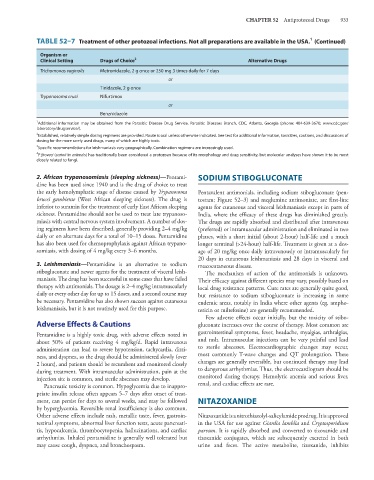Page 947 - Basic _ Clinical Pharmacology ( PDFDrive )
P. 947
CHAPTER 52 Antiprotozoal Drugs 933
1
TABLE 52–7 Treatment of other protozoal infections. Not all preparations are available in the USA. (Continued)
Organism or
Clinical Setting Drugs of Choice 2 Alternative Drugs
Trichomonas vaginalis Metronidazole, 2 g once or 250 mg 3 times daily for 7 days
or
Tinidazole, 2 g once
Trypanosoma cruzi Nifurtimox
or
Benznidazole
1 Additional information may be obtained from the Parasitic Disease Drug Service, Parasitic Diseases Branch, CDC, Atlanta, Georgia (phone: 404-639-3670; www.cdc.gov/
laboratory/drugservice/).
2 Established, relatively simple dosing regimens are provided. Route is oral unless otherwise indicated. See text for additional information, toxicities, cautions, and discussions of
dosing for the more rarely used drugs, many of which are highly toxic.
3 Specific recommendations for leishmaniasis vary geographically. Combination regimens are increasingly used.
4
P jiroveci (carinii in animals) has traditionally been considered a protozoan because of its morphology and drug sensitivity, but molecular analyses have shown it to be most
closely related to fungi.
2. African trypanosomiasis (sleeping sickness)—Pentami- SODIUM STIBOGLUCONATE
dine has been used since 1940 and is the drug of choice to treat
the early hemolymphatic stage of disease caused by Trypanosoma Pentavalent antimonials, including sodium stibogluconate (pen-
brucei gambiense (West African sleeping sickness). The drug is tostam; Figure 52–3) and meglumine antimoniate, are first-line
inferior to suramin for the treatment of early East African sleeping agents for cutaneous and visceral leishmaniasis except in parts of
sickness. Pentamidine should not be used to treat late trypanoso- India, where the efficacy of these drugs has diminished greatly.
miasis with central nervous system involvement. A number of dos- The drugs are rapidly absorbed and distributed after intravenous
ing regimens have been described, generally providing 2–4 mg/kg (preferred) or intramuscular administration and eliminated in two
daily or on alternate days for a total of 10–15 doses. Pentamidine phases, with a short initial (about 2-hour) half-life and a much
has also been used for chemoprophylaxis against African trypano- longer terminal (>24-hour) half-life. Treatment is given at a dos-
somiasis, with dosing of 4 mg/kg every 3–6 months. age of 20 mg/kg once daily intravenously or intramuscularly for
20 days in cutaneous leishmaniasis and 28 days in visceral and
3. Leishmaniasis—Pentamidine is an alternative to sodium mucocutaneous disease.
stibogluconate and newer agents for the treatment of visceral leish- The mechanism of action of the antimonials is unknown.
maniasis. The drug has been successful in some cases that have failed Their efficacy against different species may vary, possibly based on
therapy with antimonials. The dosage is 2–4 mg/kg intramuscularly local drug resistance patterns. Cure rates are generally quite good,
daily or every other day for up to 15 doses, and a second course may but resistance to sodium stibogluconate is increasing in some
be necessary. Pentamidine has also shown success against cutaneous endemic areas, notably in India where other agents (eg, ampho-
leishmaniasis, but it is not routinely used for this purpose. tericin or miltefosine) are generally recommended.
Few adverse effects occur initially, but the toxicity of stibo-
Adverse Effects & Cautions gluconate increases over the course of therapy. Most common are
Pentamidine is a highly toxic drug, with adverse effects noted in gastrointestinal symptoms, fever, headache, myalgias, arthralgias,
about 50% of patients receiving 4 mg/kg/d. Rapid intravenous and rash. Intramuscular injections can be very painful and lead
administration can lead to severe hypotension, tachycardia, dizzi- to sterile abscesses. Electrocardiographic changes may occur,
ness, and dyspnea, so the drug should be administered slowly (over most commonly T-wave changes and QT prolongation. These
2 hours), and patients should be recumbent and monitored closely changes are generally reversible, but continued therapy may lead
during treatment. With intramuscular administration, pain at the to dangerous arrhythmias. Thus, the electrocardiogram should be
injection site is common, and sterile abscesses may develop. monitored during therapy. Hemolytic anemia and serious liver,
Pancreatic toxicity is common. Hypoglycemia due to inappro- renal, and cardiac effects are rare.
priate insulin release often appears 5–7 days after onset of treat-
ment, can persist for days to several weeks, and may be followed NITAZOXANIDE
by hyperglycemia. Reversible renal insufficiency is also common.
Other adverse effects include rash, metallic taste, fever, gastroin- Nitazoxanide is a nitrothiazolyl-salicylamide prodrug. It is approved
testinal symptoms, abnormal liver function tests, acute pancreati- in the USA for use against Giardia lamblia and Cryptosporidium
tis, hypocalcemia, thrombocytopenia, hallucinations, and cardiac parvum. It is rapidly absorbed and converted to tizoxanide and
arrhythmias. Inhaled pentamidine is generally well tolerated but tizoxanide conjugates, which are subsequently excreted in both
may cause cough, dyspnea, and bronchospasm. urine and feces. The active metabolite, tizoxanide, inhibits

